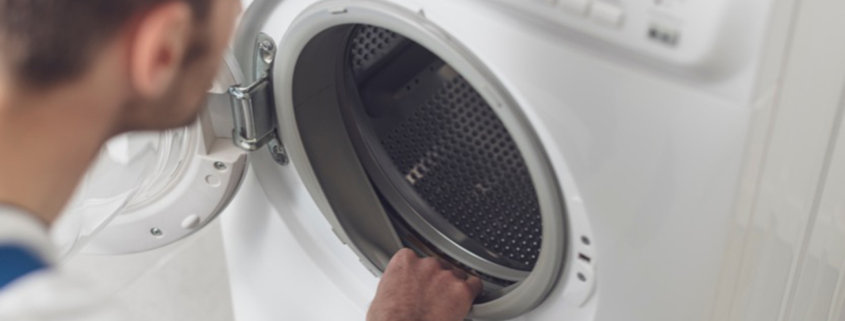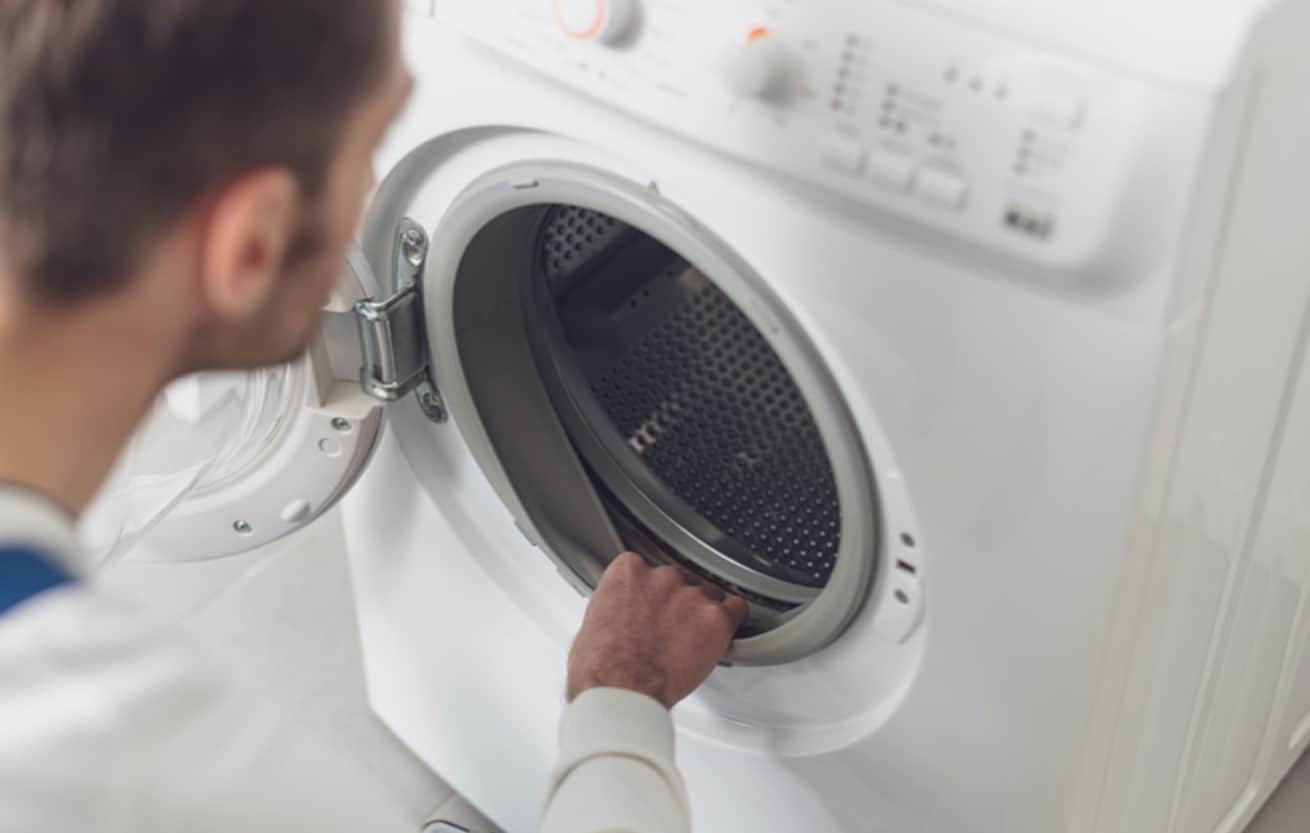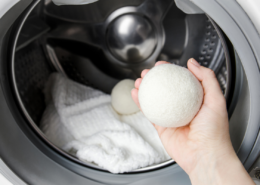How to Deep Clean a Washing Machine—Top and Front Loading (and Why You Should!)
If you assume the inside of your washer is the cleanest place in your home because you put detergent through it with every load of laundry, join the club. And that’s a really bad assumption. It’s time for us to learn how to clean a washing machine.
Have you ever wondered why there’s dirty residue on the agitator? Why do washed clothes sometimes come out with stains they didn’t have before they went in? Why do towels get stinky? Why you open the lid of the machine and get a waft of stink?
The answer is germs. According to a study by Dr. Charles Gerba, professor of microbiology at the University of Arizona, if you wash a load of just underwear, there will be 100 million E. coli in the wash water, which can be transmitted to the next load of laundry.
However, this is good to know—of the more than 60,000 germs, only one to two percent of them are potentially pathogenic. But the other 98 percent, when allowed to accumulate, can produce a terrible odor in clothes, towels, and linens—and inside the washer, too.
If you rely on laundry detergent alone to get rid of all the dirt and germs but are not occasionally using bleach and very hot water, you’re not killing the bacteria. In fact, they’re getting on your hands when you remove the wet laundry and also staying behind in the washing machine.
How to Clean a Washing Machine
You’ll need:
✅ rubber or latex gloves
✅ cleaning cloths
✅ old towels
✅ bucket or container for mixing
✅ plain white vinegar
✅ liquid chlorine bleach*
✅ hot water
If possible, turn up your water heater to at least 140 F. several hours before you clean your washer.
CAUTION
Professionals recommend keeping your water heater set at a temperature between 130 and 140 degrees Fahrenheit. Any higher or lower could be dangerous for you and your family.
While turning the temperature up higher can result in burns, turning it lower than the recommended setting can also be dangerous. In colder water temperatures, bacteria can form in the water heater tank. This could become a health risk for you and your family, potentially exposing you to health hazards such as Legionnaires’ disease.
This illness is a type of pneumonia and the bacteria that causes the illness can thrive in a water tank between the temperatures of 77 degrees and 113 degrees Fahrenheit.
Read the manual
Washing machine manufacturers almost always include a cleaning directive in the owner manual. My 9-year old GE front loader has a setting on the dial for “Clean Basket,” as do many newer washers. Start following the directions in your owner manual if you have such a setting. Or these general instructions:
Front-Loading Washing Machine
This is a multi-step process, which should be performed monthly.
- Make sure the drum of the machine is completely empty—never include any items of clothes, towels or other while cleaning the machine. Select “Basket Clean” or “Tub Clean” on the wash settings. Select the hottest, largest, and longest load settings if your front loader does not have such a setting.
- Add 2 cups of white vinegar to the empty washer drum (or to the detergent reservoir if your machine does not have a “Basket Clean” or “Tub Clean” cycle). This will help eliminate the odors and any mildew that has accumulated inside the machine. Allow the machine to run through an entire wash and rinse cycle.
- Set the washer a second time on the same cycles as above—“Tub Clean,” or “Basket Clean,” or the hottest, largest and longest cycles. Pour 2 cups of liquid chlorine bleach into the empty washer drum. This is going to kill germs and bacteria that have accumulated inside the machine. Allow the machine to run through another entire wash and rinse cycle.
- Run a third cycle on the same cycle without adding anything to the empty washer drum. This will remove and rinse away any remaining residue.
- Fill a bucket with a solution of 1/4 cup liquid chlorine bleach and 1-quart water. Dip a clean rag into the solution, ring it out. Pull back the rubber seal around the washer door, looking for mildew and other deposits. Clean this area well with the rag or scrub brush, rinsing it as needed in the bucket. Follow with a clean, dry cloth to remove any remaining moisture from the seal area.
CAUTION
Never mix bleach and vinegar. Ever. Together they produce harmful toxic gas. The cleaning process above provides for these substances to go into the machine separately, followed by complete rinse cycles to clean out the reservoirs.
Top-Loading Washing Machine
This process is similar to cleaning a front-loading machine and should be repeated monthly.
- Making sure there are no clothes in the machine, set it to the hottest, largest, and longest cycle available. Add 4 cups (1 quart) of plain white vinegar to the tub (no detergent). Close the lid and allow the machine to agitate for one minute or so. Open the lid (or press “Pause”) so agitation stops and allow the machine to sit for one hour. After one hour, allow the machine to complete a full cycle including rinse and spin.
- Leaving the same settings, fill the machine with the hottest water available and add 4 cups (1 quart) liquid chlorine bleach. Close the lid and allow to agitate for one minute, then open the lid to stop the agitation for one hour.
- After one hour, allow the machine to complete a full cycle including rinse and spin, again.
- Run a third cycle on the same settings without adding anything to the detergent reservoir. This will rinse away any remaining residue.
- Finally, using a clean cloth dipped into a mixture of 1/4 cup liquid chlorine bleach to 1-quart water, clean the area under the rim of the washer—between the basket and machine’s housing. Wipe down the detergent reservoir and clean all of the nooks and crannies of the washer that you can reach easily, where bacteria and dirt may have accumulated.
*If you don’t want to use chlorine bleach, do not assume that oxygen-based bleaches or hydrogen peroxide will give you adequate disinfectant qualities needed for cleaning. PineSol in place of liquid chlorine bleach is an acceptable and effective substitute to clean your washer. And it is septic system safe. Follow the same steps for cleaning with chlorine bleach as listed above.
More
- Dingy Gray Laundry is the Problem—This is the Solution!
- How to Make the Best Homemade Liquid Laundry Detergent
- A Simple Solution for Gross, Smelly Towels
Published: 2-28-20; Updated 11-30-22
















I have a newer washer/dryer. The washer is HE and when you load it with clothes, it spins it partially in both directions to determine how much water to use. (I think) So with nothing in it, will it add water to the machine?
It should have a “Clean” setting that overrides the HE presets. Otherwise check the owner manual.
What about those of us who live in an apartment building with washers we all have to use? Some are top loaders and others are front loaders (which I prefer). I know someone cleans everything pretty thoroughly at least twice a week, but that probably isn’t enough? I don’t use bleach except a water/bleach spray on some white items.
Hi Mary! I live out in the burbs of TX on a septic system. My dishwasher produces a stinky odor in between washes. I clean out the filter often, but the stench remains. Sprinkling Baking soda helps for a short time. Any recommendations to stop the stink?!
Thanks!
Hi Mary! Thanks for all your helpful advice! This is not relevant to Washing machines, but did you know that the Nolo will and trust maker is currently 50% off with code Monday50? I just used it myself.
Yes! Here is the link: Quicken Willmaker & Trust 2023 And be sure to use Code: MONDAY50.
I love my front loader. It never chews up any clothes. Once a week I do a load with bleach, followed by a last rinse with vinegar. Is this enough to keep the machine clean?
What a fantastic newsletter to learn by!
Thank you!
Well, thank you for that, Amy! What a fantastic audience I have in my EC Family.
My washer does not have agitator in the middle, just a steel tub. Can I do this without one?
Yes, absolutely!
Mary, although we keep our hot water set at about 120-130, when we had to purchase a new washer around 2012…actually one that you had recommended, when I did a load of laundry on the hottest setting, the water ejecting out was not even as hot as what I use to wash dishes by hand.
I called the customer service line and was told that government regulations to prevent scalding and be energy efficient, add cold water so that the temperature is at the approved 98 degrees,-even lower than normal body temperature! I asked the representative how they could sell a washer with a deep cleaning “steam frature” since all 5th graders learn you create steam at 212°. She could not answer. My new washer also does not allow the hot water to go above the safety preset temp.
I done know if putting the hot water in myself manually would screw up the load sensing thing on the washer or would that not be a factor for the cleaning process?
Many of us old people know you have to have hot water to kill germs!
I have been wondering , for quite some time now, why my washing mashing machine DOES NOT SMELL.
SOLUTION: For years, I have stopped using FABRIC SOFTENER. I use VINEGAR INSTEAD.
I’m NOT POSITIVE – but what else can it be.
Even my drawers don’t smell anymore. We were at the point of getting new bedroom CHEST OF DRAWERS furniture, until I started using VINEGAR instead of FABRIC SOFTENER. Halena
I wouldn’t be surprised! Vinegar is a wonderful natural thing … so many uses!
I have a front loading machine purchased by the previous owners of my house. I have used Affresh and didn’t care for it. I used the machine cleaning cycle and it took something like four hours!
Since that time, I run a hot water cycle with bleach, then a hot water cycle with white vinegar. I also use borax in most loads and I don’t have an issue with mold or mildew, or with my machine smelling foul. I also always leave the door open when finished with the wash. My next machine will be a top loader again.